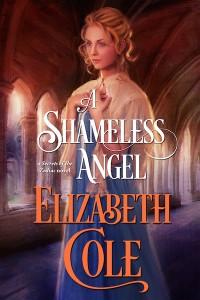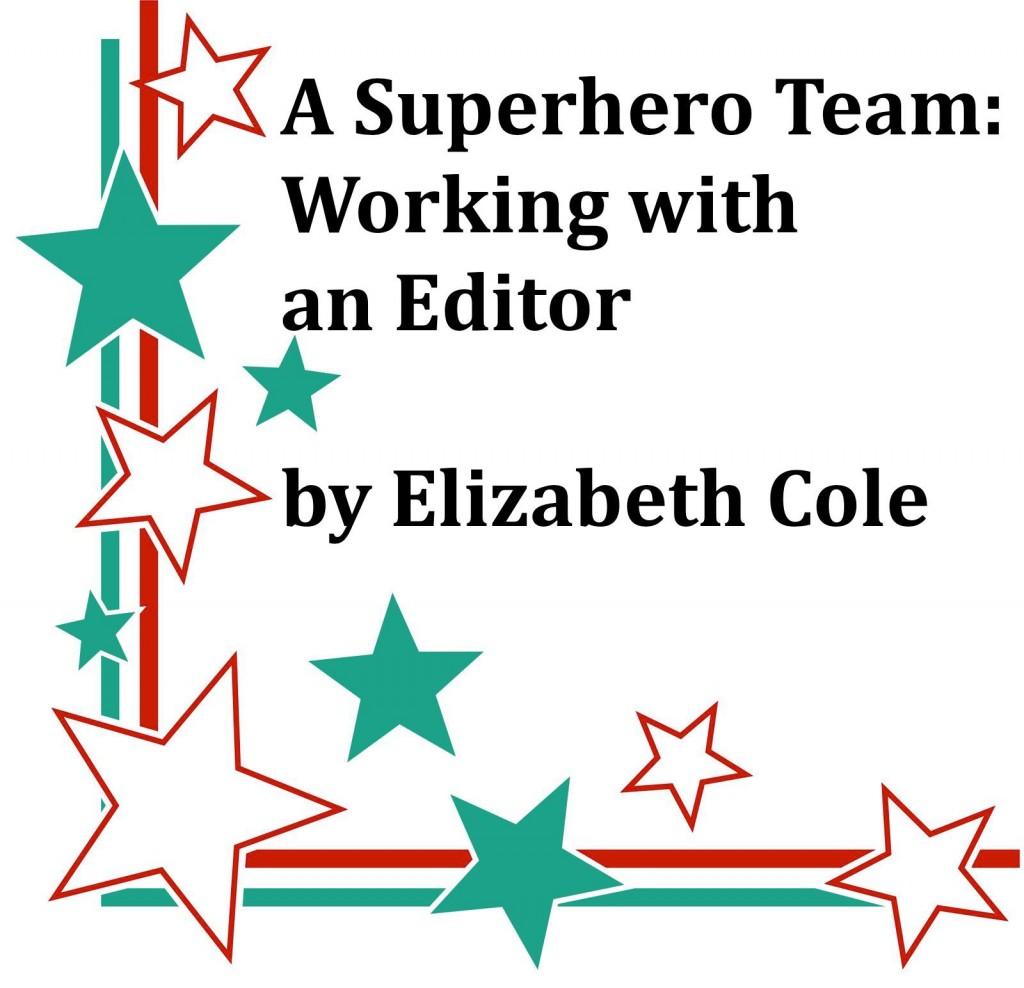A Superhero Team: Working with an Editor by Elizabeth Cole
Dear Writers,
Last Tuesday at the library, I had 16 young novelists (ages 6-13) working hard on their novels. Most of the students were just beginning to tell their stories. But a few of the students had finished a first draft—remember young NaNoWriMo participants don’t have to write 50,000 words—and were thinking about revising.
 Over the years, I’ve had the pleasure of working with many gifted editors. They’ve taught me that the right editor can support writers in making a book better. And what writer doesn’t want that? Today’s guest post from author Elizabeth Cole demystifies the different types of editing and shows her editing process from beginning to end. If you hope that manuscript you’re writing will one day become a book that strangers read, you’ll want to check out what Cole has to say!
Over the years, I’ve had the pleasure of working with many gifted editors. They’ve taught me that the right editor can support writers in making a book better. And what writer doesn’t want that? Today’s guest post from author Elizabeth Cole demystifies the different types of editing and shows her editing process from beginning to end. If you hope that manuscript you’re writing will one day become a book that strangers read, you’ll want to check out what Cole has to say!
Happy Writing! Rochelle, the Write Now! Coach
Whether you are following a traditional or indie publishing route, before you actually publish your manuscript, you’ll be working with an editor. It might be someone assigned by your publisher, or it might be a freelance editor you’ve found on your own. Yes, they do cost money. That’s because they add value to your work. If you want a good product, you need to invest in it. That includes not only the time you put into writing it, but also the money to pay professionals to get the final package ready. Editing is part of that package.
There are different types of editing, all with different rates and goals.
*Proofreading is the most basic type. Proofreaders check spelling, make sure you didn’t use discreet when you meant discrete, and put all your commas in the right place. And that’s it.
*Copyediting is the next step up in complexity. A copyeditor actually reads the piece for coherency and logic. A copyeditor will tell you when Parvati’s pants change from blue to orange in the same scene, or that Emmy was super mean to your protagonist in the beginning, but then becomes besties with her in the next chapter with no explanation.
*Developmental editing is even more high-level. A developmental editor will read your story multiple times to examine how the plot arcs and how the themes are fitting in. He’ll tell you that the mood of the story waffles from comic to dark and back, but maybe not in the way it should. He’ll offer different ideas for fixing larger-scope problems in your manuscript.
*Many editors end up doing a mix of these roles, and charge accordingly.
Got all that? Great. Now we can talk about actually working with your editor. The writer and editor work as a team. An editor is neither a slave nor a genie. They’re professional contractors hired to make your work the best it can be. You must work with them.
Now, those categories I just mentioned? They’re actually listed backwards. In most cases, you’ll want to handle developmental editing first, then copyediting, than finally proofreading. Of course, the writer/editor work relationship is going to be unique for everyone. Your project is one of a kind, right? So I’ll just describe my own process to show you one method.
First, I spend a chunk of time working on the first draft of a novel. Personally, I don’t like showing parts of a draft to anyone, and I don’t like soliciting feedback until the first draft is done (that means no missing sections, no internal notes to self, no “ADD SOME PLOT HERE” messages, etc.). I want to hand off a piece that is readable by someone who has no info beforehand. That way, it most directly reflects the typical reader experience.
I self-edit the whole piece for coherency, and do a basic proofread and spellcheck. Then, I send copies to both my editor and beta readers (Ideally, you’d do beta readers first, but so often time does not allow for that extra month or two to send a novel out and wait for responses from the slowest readers. Functionally, it works just fine to do it all at once. I incorporate beta reader feedback into the second draft just as I do my editor’s feedback).
My editor does a first pass of the novel draft. She will note typos, change minor words or phrases if they’re awkward, and make lots of comments. All of these things happen digitally, I should add. No paper is printed or sent at any point in the process. I never meet with my editor in person as part of the process. Occasionally, we have a phone call to talk about story things that require a back-and-forth. But most of the process is online. We use the track changes tool to add comments and questions. At this stage, her comments might be things like: “This seems out of character for your shy protagonist.” or “I’d like to see more about the dog after Chapter X. It drops out after that point.” or “You say he’s 35 years old here, but 33 in a previous chapter.” Basically, anything that needs clarification or a second look. Some things are easy to fix. Others require additional passages to be written, or scenes to move around a bit. I’ll spend a few days or a week on these items.
Then I send the clean second draft (i.e. with every single comment or change accepted or rejected) back to my editor. She reads it again. There are more comments and more changes, but with luck, they’re more fine-grained (word choice in a character’s speech, or emphasizing a mood or tone in one scene). I go through it once again, attacking each tag or yellow bubble. Sometimes I’ll send a quick email to my editor regarding a particular issue, but once I resolve everything, I send the file to my publisher to be formatted.
Once it is, I send that new file back to my editor once last time for the proofreading pass. (I also do another proof pass, and so does one other person.) A note about proofreading: you can never have too many eyes. Someone will always catch something that five other people missed. It doesn’t mean anyone is bad at their job. But when you have 100,000 words and tons of punctuation, typos will flourish. It’s just the nature of things. Fix them and move on.
After everyone has proofed the file and all the changes are made, the book is ready for the final stage. My publisher adds front and back matter, cover art, metadata, and such. Then—on publication day, which we hope has not been moved back because of deadlines getting missed—the book goes up for sale! Easy peasy, right?
Depending on type of work you’re doing, maybe you only need to send the piece to your editor once. Maybe you’ll have five passes. Every piece is unique. But if you’re a career writer like I am, you’ll be writing piece after piece, and soon you’ll develop a workflow with your editor. I’ve been lucky in that I’ve had the same reliable editor every time. If you aren’t satisfied with yours, go find a different one. (If you’re working with a publishing house, you can request a different one, though you have much less control in that situation.) Not everyone has a compatible working style, so don’t think of it as a failure. It’s just part of the process.
One thing is true no matter what: all writing requires editing. All. Don’t try to skip it, and don’t breeze through it. Quality editing will make your work better. It’s well worth the extra time and effort to get it right.
 About the author. Elizabeth Cole is a romance author with a penchant for history, which is why she lives in an old house in an old city. She can be found hanging around libraries and archives, or curled in a corner reading, cat on lap. She believes in love at first sight. Then again, she also believes that mac ‘n’ cheese is a healthy breakfast, so don’t trust her judgment on everything. Find out more about her work and get some free books at elizabethcole.co
About the author. Elizabeth Cole is a romance author with a penchant for history, which is why she lives in an old house in an old city. She can be found hanging around libraries and archives, or curled in a corner reading, cat on lap. She believes in love at first sight. Then again, she also believes that mac ‘n’ cheese is a healthy breakfast, so don’t trust her judgment on everything. Find out more about her work and get some free books at elizabethcole.co









